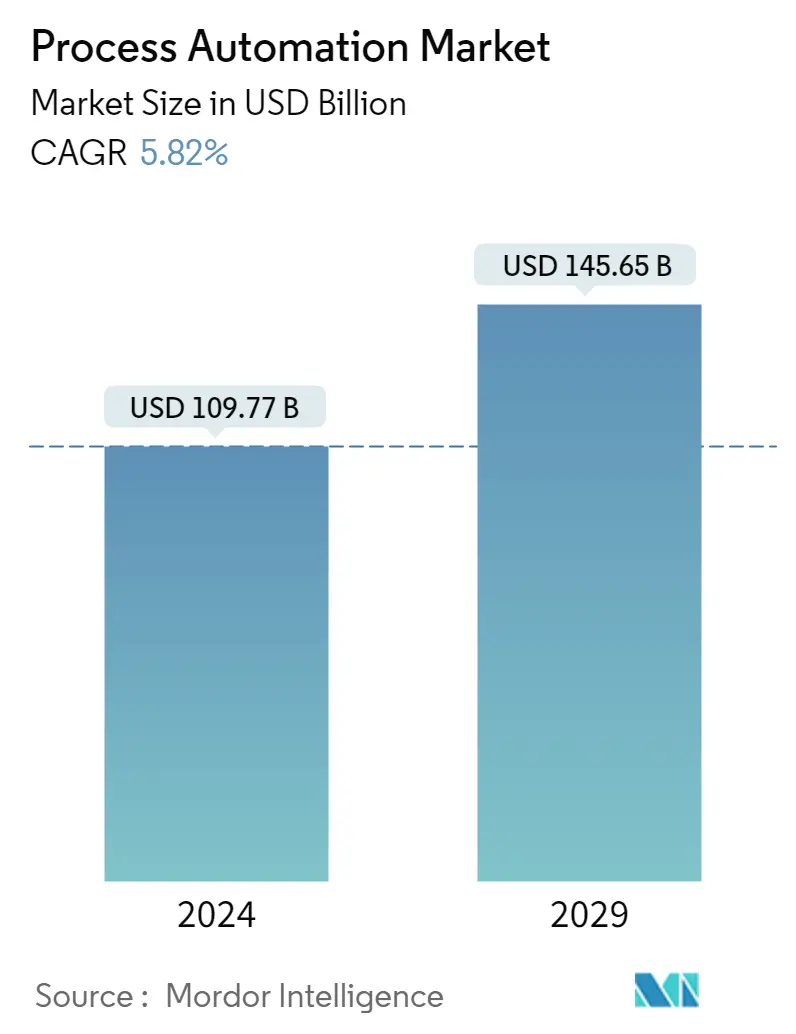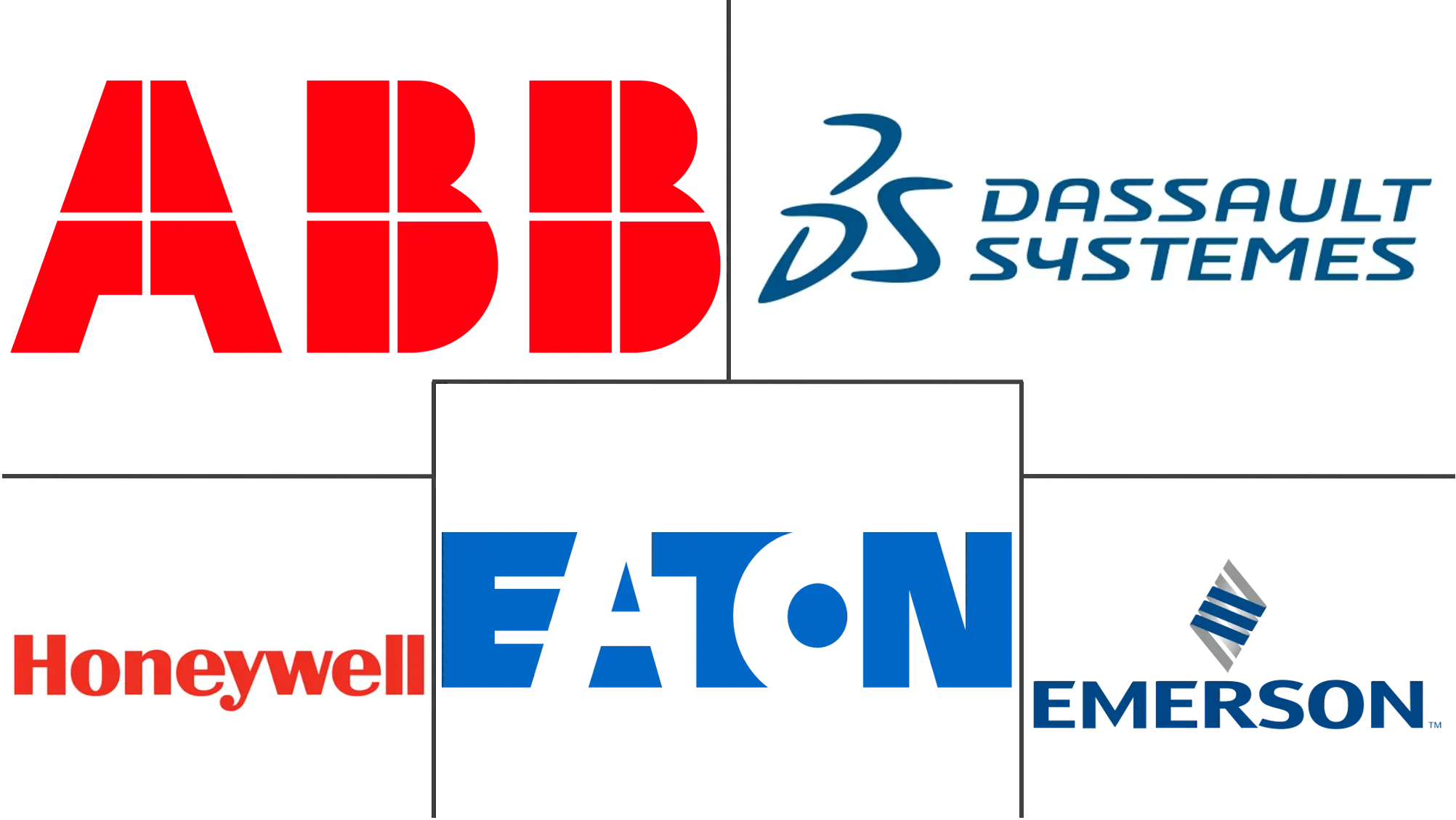Market Size of Process Automation Industry

| Study Period | 2019 - 2029 |
| Market Size (2024) | USD 109.77 Billion |
| Market Size (2029) | USD 145.65 Billion |
| CAGR (2024 - 2029) | 5.82 % |
| Fastest Growing Market | Asia Pacific |
| Largest Market | North America |
| Market Concentration | Medium |
Major Players
*Disclaimer: Major Players sorted in no particular order |
Process Automation Market Analysis
The Process Automation Market size is estimated at USD 109.77 billion in 2024, and is expected to reach USD 145.65 billion by 2029, growing at a CAGR of 5.82% during the forecast period (2024-2029).
The Industrial Internet of Things (IIoT) and the Industrial 4.0 are at the center of new technological approaches for development, production, and management of the entire logistics chain, otherwise known as smart factory automation and are dominating trends in the industrial sector, with machinery and devices being connected via the internet. The number of IoT connected devices rose to 20.35 billion in 2017 from 15.41 billion in 2015 and is expected to reach 51.11 billion by 2023, given the huge push from the investment of the technology providers through continuous research and development.
- The growing emphasis on energy efficiency and cost reduction drives the market. The rising digital revolution resulted in an increased focus on automation, which is likely to improve quality and flexibility in the manufacturing process. Governments across the world enacted various policies in favor of automation, with an intention to improve energy efficiency while reducing the costs incurred. For instance, in 2019, Malaysian government launched a National Policy on Industry 4.0 (Industry4WRD). A budget of over USD 1.2 billion was allocated to help businesses adopt Industry 4.0.
- Within the allocated budget, a total of USD 720 million was allocated to accelerate the adoption of smart technologies, such as automation, in addition to robotics and artificial intelligence under the name as Industry Digitalization Transformation Fund, and USD 480 million was allocated under the Business Loan Guarantee Scheme (SJPP) for SMEs planning to invest in automation and modernization.
- Further, the demand for safety automation systems drives the market. In the present day, businesses are provided with significant incentives, primarily investments in automated systems, owing to technological advancement. Automation can also provide solutions to address persistent safety challenges, and, thereby, attracting the industry players to deploy safety automation systems, in addition to achieving higher levels of efficiency and precision.
- For instance, Bosch's plant in Toluca, Mexico, has been using photoelectric light curtains around a machine whose work involves the installation of needle bearings in engine shafts. These light curtains have been responsible to greatly improve the safety and productivity of the machine. Thus, technological advancements will allow manufacturers to incorporate machine learning and other artificial intelligence solutions, mainly to enhance safety.
- Further, theCOVID-19 pandemic created an economic turmoil for small, medium, and large-scale industries across the world. The country-wise lockdown inflicted by the governments around the world, to minimize the spread of the virus, impacted the growth of industries. Due to pandemic, it forced the businesses to adhere to strict requirements in order to ensure the ongoing safety of their employees and customers. As a result, the need for automation witnessed a sudden spike. This is expected to be observed as a notable trend in the foreseeable future, as automation could become the new normal.
- In addition to ensuring that businesses are capable of meeting target production levels in these times, automation can also support the gradual recovery post the control of epidemic, to a larger extent. The situation may also serve to accelerate the investments in automation across process industries, primarily with an intent to bridge the productivity gap, when the global economy eventually rebounds, but gradually.
Process Automation Industry Segmentation
The automation industry has been revolutionized by a combination of the digital and physical aspects of manufacturing, aimed at delivering optimum performance. Further, the focus on achieving zero waste production and shorter time to market has augmented the growth of the market. The market study comprises of Technology such as SCADA, DCS, PLC, MES, Valves and Actuators, and others, providing solutions to end-users such as Chemical and Petrochemical, Paper and Pulp, Water and Wastewater Treatment, etc.
| System Type | |
| Supervisory Control and Data Acquisition (SCADA) | |
| Programmable Logic Controller (PLC) | |
| Distributed Control System (DCS) | |
| Machine Execution System (MES) | |
| Valves and Actuators | |
| Electric Motors | |
| Human Machine Interface (HMI) | |
| Process Safety Systems | |
| Sensors and Transmitters | |
| Other Systems |
| Communication Protocol | |
| Wired Protocol | |
| Wireless Protocol |
| End-user Industry | |
| Chemical and Petrochemical | |
| Paper and Pulp | |
| Water and Wastewater Treatment | |
| Energy and Utilities | |
| Oil and Gas | |
| Pharmaceutical | |
| Food and Beverages | |
| Other End-user Industries |
| Geography | ||||||
| ||||||
| ||||||
| ||||||
| Latin America | ||||||
| Middle East and Africa |
Process Automation Market Size Summary
The process automation market is poised for significant growth, driven by the integration of the Industrial Internet of Things (IIoT) and Industry 4.0 technologies. These advancements are central to the development of smart factory automation, which enhances the efficiency and connectivity of industrial operations. The market is experiencing a surge in demand due to the increasing focus on energy efficiency, cost reduction, and the digital revolution, which emphasizes automation to improve manufacturing quality and flexibility. Government initiatives worldwide, such as Malaysia's National Policy on Industry 4.0, are further propelling the adoption of automation technologies by providing financial support and incentives for businesses to modernize their operations. The COVID-19 pandemic has also accelerated the need for automation, as businesses seek to ensure safety and maintain productivity amidst global disruptions.
In the pulp and paper industry, process automation is becoming essential to meet the demands for reduced production costs and increased yields. The adoption of Distributed Control Systems (DCS) is a key trend, with companies like Valmet supplying advanced automation solutions to enhance operational efficiency. The US manufacturing sector is also witnessing a shift towards AI and automation, supported by federal initiatives like the Advanced Manufacturing Partnership, which aims to foster innovation and competitiveness. Additionally, the market is characterized by a competitive landscape with major players such as ABB Ltd and Eaton Corporation focusing on strategic collaborations to expand their global presence. These developments underscore the dynamic nature of the process automation market, which is expected to continue its growth trajectory in the coming years.
Process Automation Market Size - Table of Contents
-
1. MARKET DYNAMICS
-
1.1 Market Overview
-
1.2 Industry Attractiveness Porters Five Force Analysis
-
1.2.1 Threat of New Entrants
-
1.2.2 Bargaining Power of Buyers/Consumers
-
1.2.3 Bargaining Power of Suppliers
-
1.2.4 Threat of Substitute Products
-
1.2.5 Intensity of Competitive Rivalry
-
-
1.3 Industry Value Chain Analysis
-
1.4 Technology Snapshot
-
1.5 Impact of COVID-19 on the Automation Industry
-
1.6 Introduction to Market Drivers and Restraints
-
1.7 Market Drivers
-
1.7.1 Rising Adoption of Robotics
-
1.7.2 Growing Emphasis on Energy Efficiency and Cost Reduction
-
1.7.3 Emergence of IIoT
-
1.7.4 Demand for Safety Automation Systems
-
-
1.8 Market Challenges
-
1.8.1 Cost and Implementation Challenges
-
-
-
2. MARKET SEGMENTATION
-
2.1 System Type
-
2.1.1 Supervisory Control and Data Acquisition (SCADA)
-
2.1.2 Programmable Logic Controller (PLC)
-
2.1.3 Distributed Control System (DCS)
-
2.1.4 Machine Execution System (MES)
-
2.1.5 Valves and Actuators
-
2.1.6 Electric Motors
-
2.1.7 Human Machine Interface (HMI)
-
2.1.8 Process Safety Systems
-
2.1.9 Sensors and Transmitters
-
2.1.10 Other Systems
-
-
2.2 Communication Protocol
-
2.2.1 Wired Protocol
-
2.2.2 Wireless Protocol
-
-
2.3 End-user Industry
-
2.3.1 Chemical and Petrochemical
-
2.3.2 Paper and Pulp
-
2.3.3 Water and Wastewater Treatment
-
2.3.4 Energy and Utilities
-
2.3.5 Oil and Gas
-
2.3.6 Pharmaceutical
-
2.3.7 Food and Beverages
-
2.3.8 Other End-user Industries
-
-
2.4 Geography
-
2.4.1 North America
-
2.4.1.1 United States
-
2.4.1.2 Canada
-
-
2.4.2 Europe
-
2.4.2.1 United Kingdom
-
2.4.2.2 Germany
-
2.4.2.3 France
-
2.4.2.4 Rest of Europe
-
-
2.4.3 Asia-Pacific
-
2.4.3.1 China
-
2.4.3.2 India
-
2.4.3.3 Japan
-
2.4.3.4 Rest of Asia-Pacific
-
-
2.4.4 Latin America
-
2.4.5 Middle East and Africa
-
-
Process Automation Market Size FAQs
How big is the Process Automation Market?
The Process Automation Market size is expected to reach USD 109.77 billion in 2024 and grow at a CAGR of 5.82% to reach USD 145.65 billion by 2029.
What is the current Process Automation Market size?
In 2024, the Process Automation Market size is expected to reach USD 109.77 billion.

